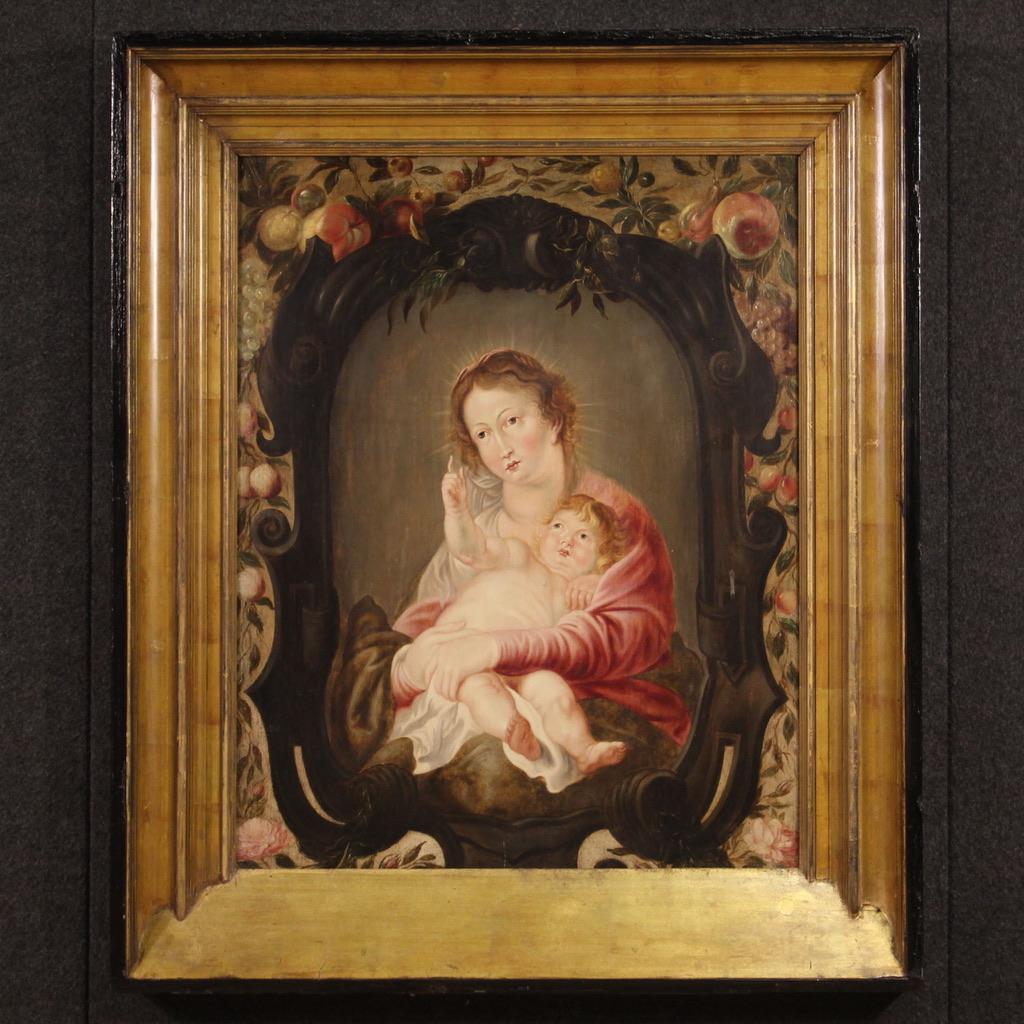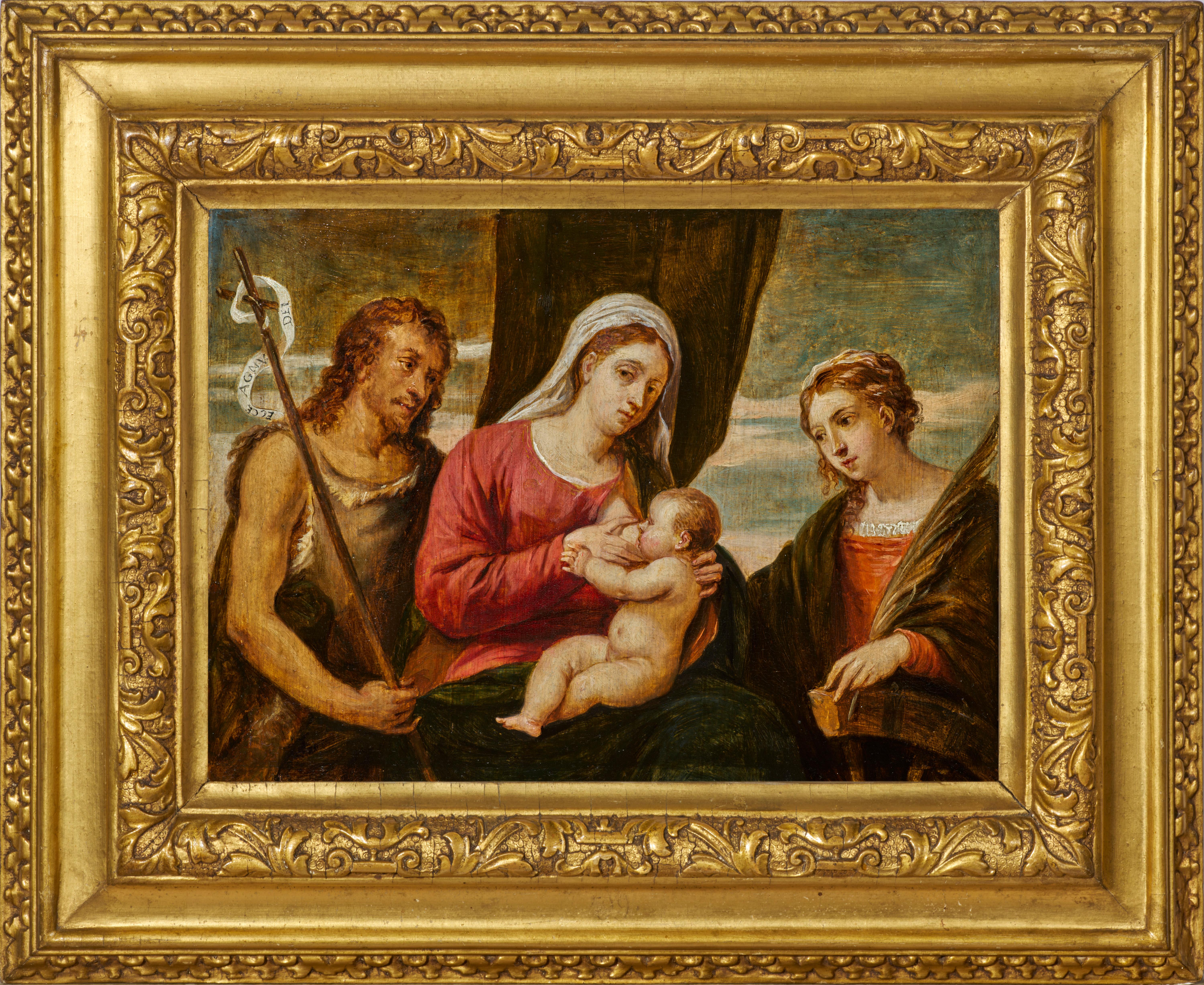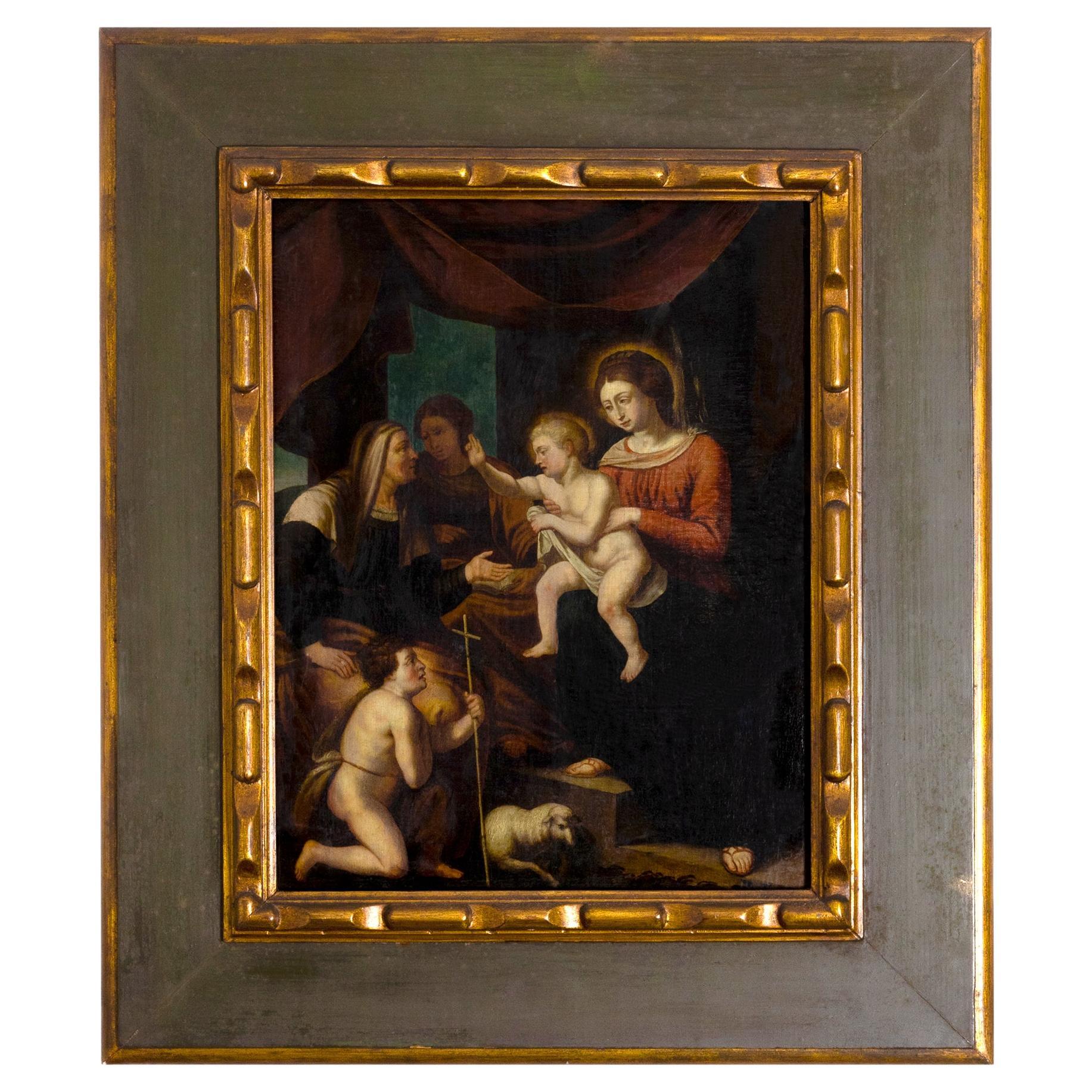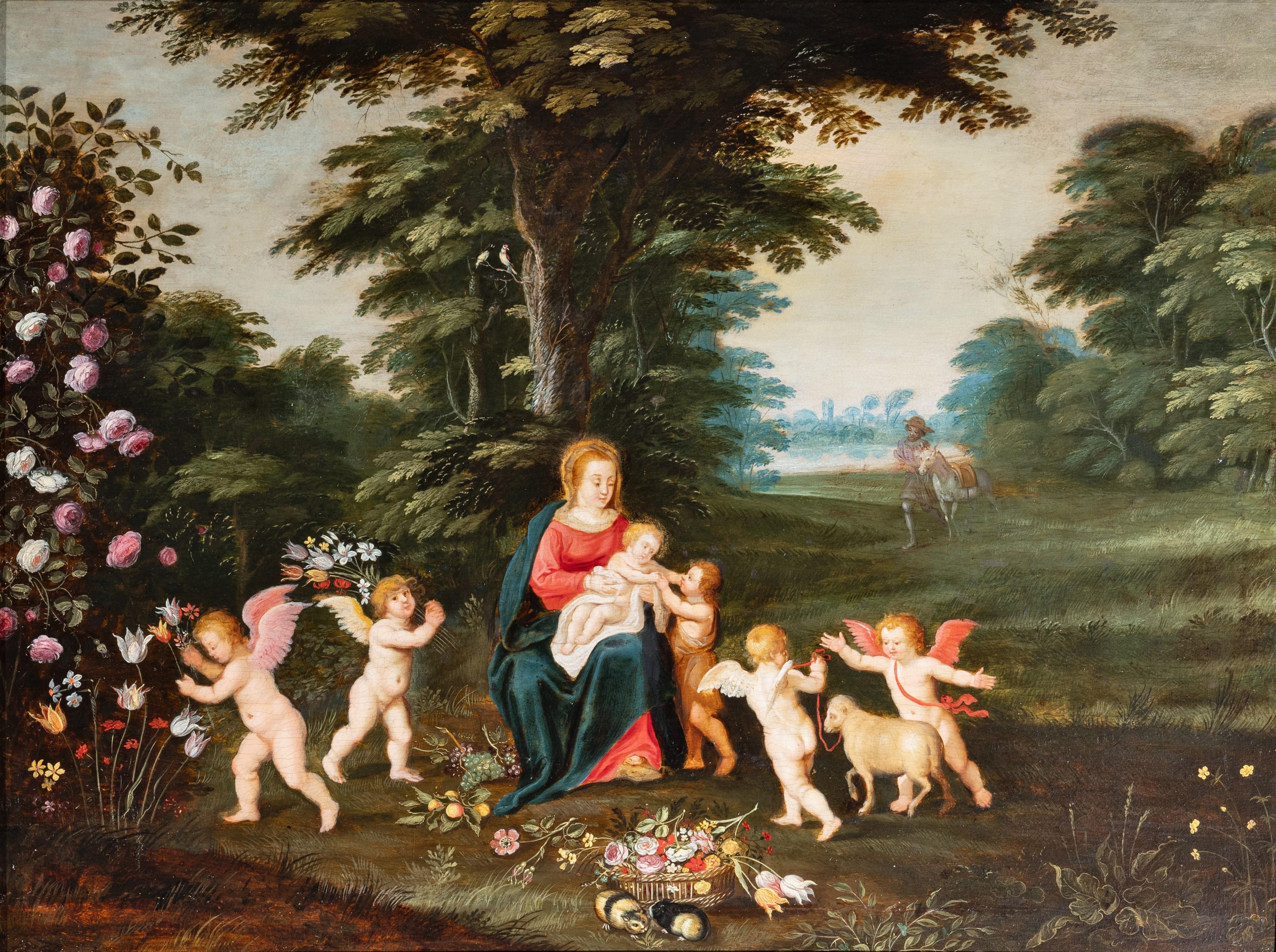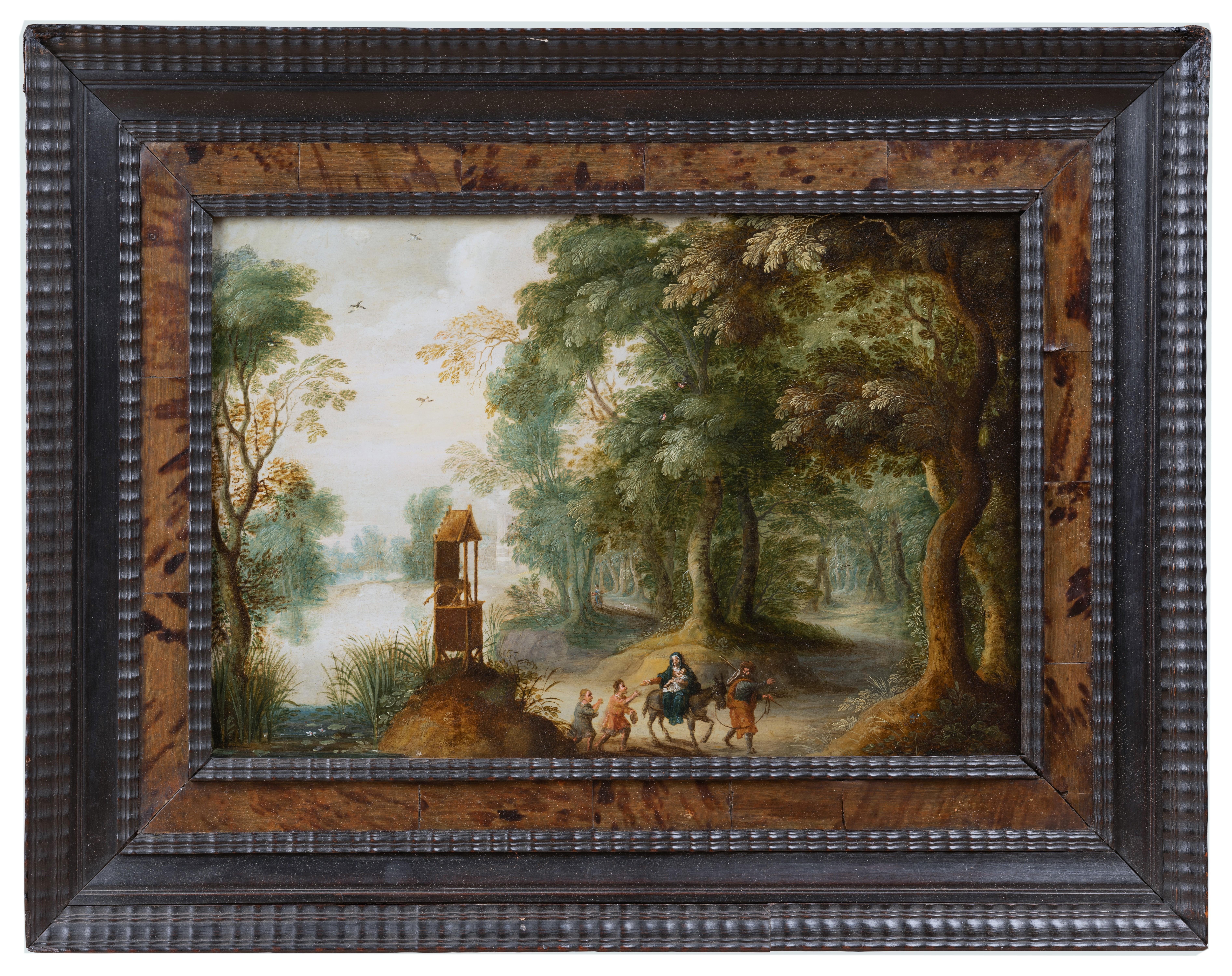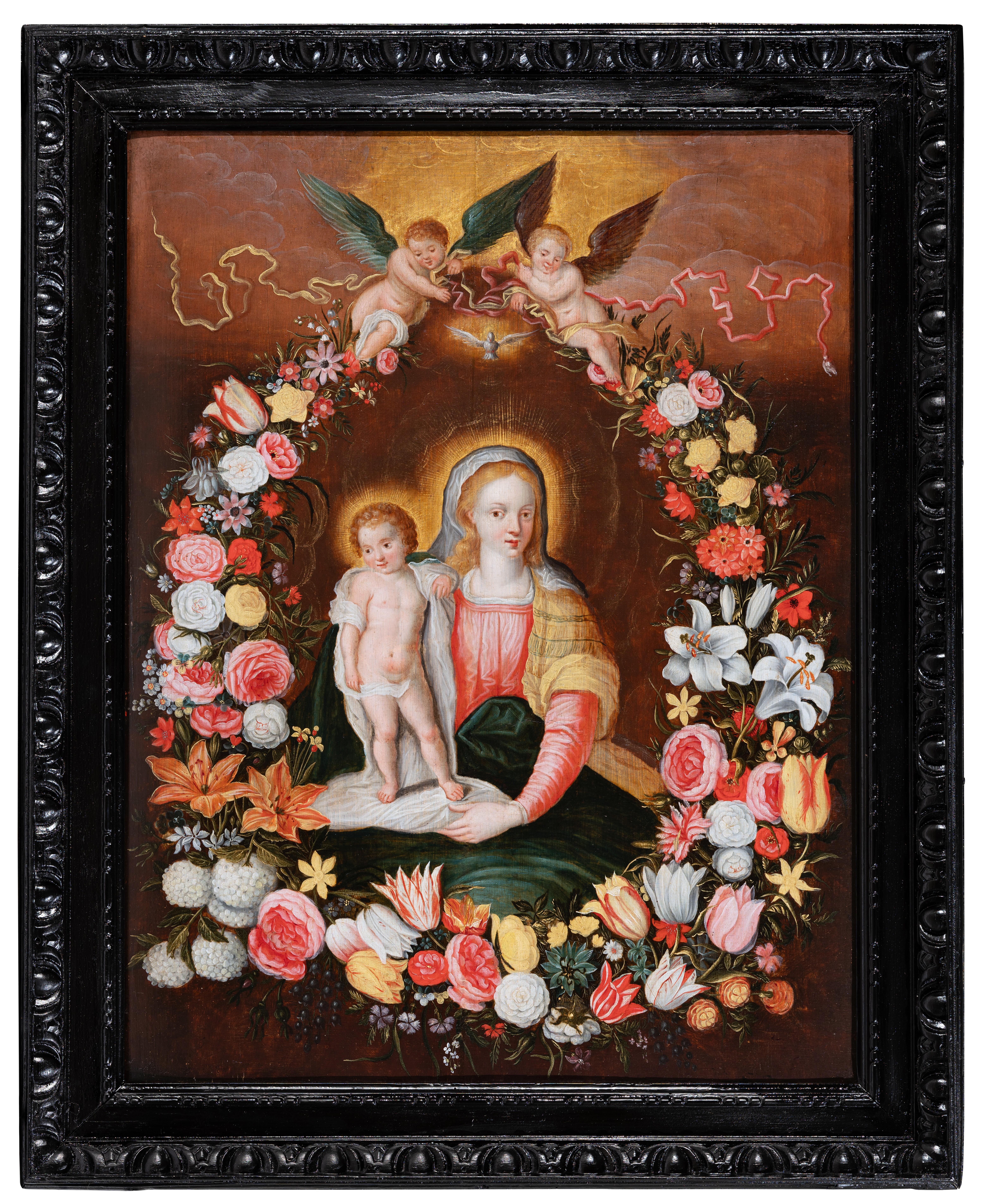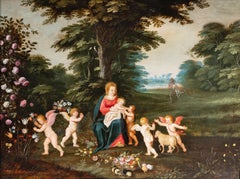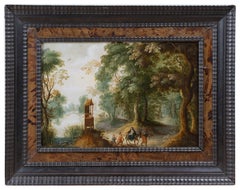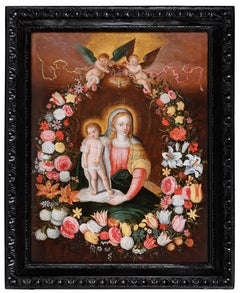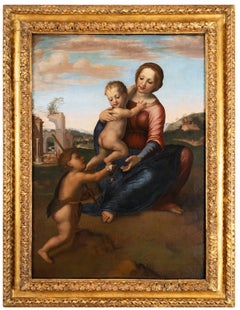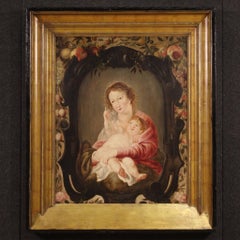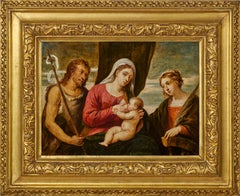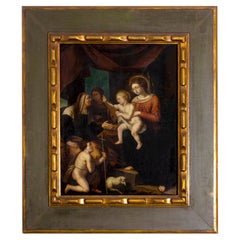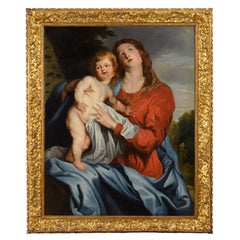Items Similar to 17th c. Antwerp studio of J. Brueghel & H. van Balen - The Virgin with Child
Want more images or videos?
Request additional images or videos from the seller
1 of 17
17th c. Antwerp studio of J. Brueghel & H. van Balen - The Virgin with Childunknown
unknown
$33,489.96
£24,909.33
€28,000
CA$46,772.98
A$50,760.19
CHF 26,707.84
MX$616,737.70
NOK 334,377.08
SEK 314,846.44
DKK 213,244.65
About the Item
Workshop of Jan Brueghel the Younger (1601-1678) & Hendrick van Balen (Antwerp, 1575 – 1632)
17th century Antwerp School
The Virgin and Child with Saint John the Baptist Surrounded by Angels in a Landscape
Oil on oak panel: h. 54 cm (21.26in), w. 77cm (30.31 in)
Flemish style frame in molded wood
Box: h. 67.5 cm (26.57 in), w. 89.5 cm (35.24 in)
Our work illustrates a scene from the biblical story recounting the episode of "Rest on the Flight into Egypt." Unlike the traditional versions representing the Holy Family, our painting illustrates the Virgin and Child alone without Saint Joseph.
In the heart of a lush wooded landscape, the Virgin Mary rests in a clearing accompanied by seven joyful putti. Seated to the left of the composition, the Virgin Mary holds the Child on her knees; the young Saint John the Baptist, kneeling, offers him a tulip.
On the right a group of cherubs amuse themselves with the lamb of Saint John the Baptist, thus bringing a jovial character to the scene. One of the angels holds in his hands the bunches of grapes (symbol of the future passion of Christ). A pair of garden putti on the left carry a basket filled with freshly picked flowers.
While in heaven another group of angels appearing in a breakthrough bringing a wreath for Mary.
In the background, in a luminous opening towards the horizon, enriched with shades of green, a small town is emerging with a few grazing animals.
The calm magnitude of this bucolic forest opening onto luminous distances is particularly suited to this sacred scene of Rest on the Flight into Egypt.
Our painting is one of the variants produced in the workshops of Jan Brueghel the Younger and Hendrick Van Balen. His studio works executed by collaborators of the painters in question are inspired by the success of the compositions dating from the late 1620s-1630s, painted by Jan Breughel the Younger in collaboration with Hendrick Van Balen. Many versions of the painters or workshop are kept in public and private collections. It is mostly oil on panels with almost identical dimensions to our panel. The compositions vary around the Virgin and Child by integrating puttis and angels in the different postures.
Related works:
- Jan Bruegel le Jeune & Hendrick van Balen, Collection Liechtenstein Vaduz– Vienna, oil on panel (53 × 74 cm), vers 1626,
-Jan Bruegel le Jeune & Hendrick van Balen, Columbus Museum of Art, USA, oil on panel h. 49 cm, l. 64 cm vers 1620,
- Jan Brueghel le Jeune & Pieter van Avont, National Trust, Royaume Uni (inv. 436022) , oil on panel (68 × 84 cm), 1636,
- Jan Breughel le Jeune & Hendrik van Balen, Sotheby's London, 10/07/2014, lot n 133, oil on panel, 55 x 77.5 cm, 1626
- Jan Van Balen, Dorotheum auction, Vienna, 24/04/2018, lot 241, oil on panel, 54.5 x 77.7 cm
- Workshop de Hendrick van Balen Staatliche Kunsthalle, Karlsruhe, oil on panel, 54.8cm x 77.8cm
- Attributed to:Jan Brueghel the Younger (1601-1678) & Hendrick van Balen (Antwerp, 1575 – 1632) (1601 - 1678, Belgian)
- Creation Year:unknown
- Dimensions:Height: 26.57 in (67.49 cm)Width: 35.24 in (89.51 cm)
- Medium:
- Movement & Style:
- Period:1630-1639
- Condition:Very good original condition, cleaned and revarnished by our professionnal art restorer.
- Gallery Location:PARIS, FR
- Reference Number:1stDibs: LU2433213531682
About the Seller
No Reviews Yet
Vetted Professional Seller
Every seller passes strict standards for authenticity and reliability
1stDibs seller since 2023
17 sales on 1stDibs
- ShippingRetrieving quote...Shipping from: PARIS, France
- Return Policy
Authenticity Guarantee
In the unlikely event there’s an issue with an item’s authenticity, contact us within 1 year for a full refund. DetailsMoney-Back Guarantee
If your item is not as described, is damaged in transit, or does not arrive, contact us within 7 days for a full refund. Details24-Hour Cancellation
You have a 24-hour grace period in which to reconsider your purchase, with no questions asked.Vetted Professional Sellers
Our world-class sellers must adhere to strict standards for service and quality, maintaining the integrity of our listings.Price-Match Guarantee
If you find that a seller listed the same item for a lower price elsewhere, we’ll match it.Trusted Global Delivery
Our best-in-class carrier network provides specialized shipping options worldwide, including custom delivery.More From This Seller
View AllRest on the Flight into Egypt - Attributed to Pieter Van Avont - 17th c. Flemish
By Pieter van Avont
Located in PARIS, FR
Rest during the Flight into Egypt - The Virgin and Child with St. John the Baptist and the angels in a Landscape.
Attributed to Pieter Van Avont (1600-1652)
17th century Antwerp School, circa 1630
Oil on oak panel,
Dimensions: h. 38 cm, w. 50 cm (14.96 in x 19.68 in)
Flemish style frame in ebonized and moulded wood
Framed: h. 56 cm, w. 68.5 cm (22.04 in. x 26.97 in.)
In the heart of a lush wooded landscape, the Virgin with Jesus rests in a green clearing accompanied by Saint John the Baptist and the cherubs. Seated to the left of the composition, the Virgin Mary holds the Child on her lap; the little Saint John the Baptist wearing the camel-skin tunic (his attribute) stands before Jesus to exchange a few caresses. On the right, the couple of cherubs are playing with the lamb of Saint John the Baptist, bringing a jovial character to the scene. A pair of gardening putti on the left pick flowers to bring bouquets to the Virgin and Jesus. Spring flowers such as tulips, daffodils and anemones that grow abundantly around them and enrich the composition with their shimmering colors. A lush rose bush blooms to the left of the figures offering delicate roses. (The rose is the flower associated with the Virgin Mary, who is the "mystical rose," the one that does not bear the "thorn of sin")
At the feet of the Virgin are bunches of grapes (symbol of the future passion of Christ) as well as apples (symbol of the original fall of Man but also of the Redemption in Christ) In the foreground we find a wicker basket filled in profusion with beautiful flowers and guinea pigs nibbling on the blades of grass. In a cleverly arranged disorder, these elements of the still life with their strong symbolic power accentuate the religious theme, but are also an opportunity for the artist to demonstrate his know-how in the still life genre that is gaining momentum in Antwerp. The landscape behind the figures consists of a large tree with a twisted trunk and a luminous opening to the horizon placed on the right. We see Saint Joseph arriving with a donkey, a small reminder from the artist that the composition is associated with the episode of Rest during the flight into Egypt.
The calm expanse of this bucolic forest opening onto the luminous distance, with its profusion of symbolic flowers and fruits, is particularly suited to this sacred scene. The theme of Jesus' sacrifice and his tragic fate is mitigated by cherubs who play with innocence and carelessness in the face of the fragility of life symbolized by cut flowers. The great mastery of the painter is manifested by the finesse of the drawing enhanced by the delicacy in the application of the brushstrokes bringing a multitude of details. The richness of the whole is exacerbated thanks to the choice of colours, this varied palette is an undeniable asset of our work.
The virtuosity of our artist lies in his versatility, as much concerned with the success of the landscape and flowers as with the modelling of his figures. The cherubs with their naked bodies are gracefully illuminated by warm colours with subtle shadows, while the still life is rendered with astonishing realism, both in the precision of the drawing and in the countless shades of the flowers.
There are several compositions similar to ours, of which below are the closest versions:
• Sale, Jean-Claude Anaf et Associés, Lyon, 08/02/1998, attributed to Pieter Van Avont, oil on panel, h. 48 cm, l. 71 cm (recorded on RKD n° 31451). Comment: identical composition, only St Joseph with the donkey is different)
• Christie's New York sale, 29/01/1998, Pieter Van Avont, oil on copper, h. 23.8 cm, w. 24.8 cm
• Dorotheum sale, Vienna, 25/04/2017, Pieter Van Avont and Jan Breughel II, oil on copper, h .26 cm, w. 39 cm
• Hermitage Museum, Saint Petersburg, Russia, Pieter Van Avont, oil on panel, h. 50.5 cm, w. 71.7 cm
Peter van Avont, Flemish painter (Mechelen, 1600 - Antwerp. 1652)
Born in Mechelen, he is mentioned in 1620 as a member of the painters' guild of his hometown. He left in 1 622 for Antwerp, where he was also a member of the guild. He collaborated with many painters, including Jan Brueguel the Younger, David Vinckboons, Lucas van Uden...
Category
17th Century Old Masters Landscape Paintings
Materials
Oak, Oil
17th c. Flemish - Landscape with Flight to Egypt - Antwerp circa 1630
Located in PARIS, FR
LANDSCAPE WITH FLIGHT TO EGYPT,
JASPER VAN DER LANEN (ANTWERP, 1585 - 1634)
17TH CENTURY FLEMISH SCHOOL
ANTWERP CIRCA 1630
Oil on copper, dimensions: h. 10.23 in, w. 14.96 in
Flemish style frame in ebonized wood adorned with wavy moldings and wood veneer.
Framed dimensions: h. 17.32 in, w. 21.65 in
Provenance:
Philips auction...
Category
Early 17th Century Old Masters Figurative Paintings
Materials
Copper
$9,628 Sale Price
30% Off
Virgin & Child in a Flower Garland, Flemish, 17th century, studio of F. Francken
By Frans Francken II
Located in PARIS, FR
Virgin and Child in a Garland of Flowers
Studio of Frans Francken II (1581-1642)
This work is unsigned
17th century Antwerp School
Oil on oak panel
Dimensions: h. 63 cm, w. 48,5 cm (...
Category
Early 17th Century Old Masters Figurative Paintings
Materials
Oil, Wood Panel
17th century Italian school, The Virgin and Child with Saint John the Baptist
Located in PARIS, FR
17th century Italian School
The Virgin and Child with Saint John the Baptist
Oil on canvas
Dimensions: h. 106 cm, l. 77 cm
Important 17th century Italian carved giltwood frame
Fram...
Category
17th Century Old Masters Figurative Paintings
Materials
Canvas, Oil
Flemish 17th c., Allegory of war and peace, circa 1630, by Adriaen van Stalbemt
Located in PARIS, FR
Adriaen van Stalbemt (Antwerp, 1580-1662)
Allegory of Peace and War, circa 1620-1630
Oil on oak panel: h. 49.5 cm, l. 73.2cm (19.29 x 28.74 in)
Giltwood ...
Category
Early 17th Century Old Masters Figurative Paintings
Materials
Oil, Panel
The Rape of Europa, signed Peter Sion (1624-1695), Antwerp, 17th century
Located in PARIS, FR
The Rape of Europa
By Peter Sion (Antwerp, 1624-1695)
Signed in the lower right corner P. Sion
17th century Antwerp School
Oil on copper, dim. h. 53 cm, w. 45 cm
Moulded and ebonized...
Category
17th Century Old Masters Figurative Paintings
Materials
Oak, Oil, Wood Panel
You May Also Like
17th Century Oil on Panel Flemish Religious Painting Madonna with Child, 1670
Located in Vicoforte, IT
Antique Flemish panel from the first half of the 17th century. Oil painting depicting a splendid Madonna with child inside a niche surrounded by a garland of masterfully painted flow...
Category
1670s Figurative Paintings
Materials
Oil, Wood
$8,611 Sale Price
20% Off
Virgin and Child, a paiting by David Teniers the Younger after Palma Vecchio
By David Teniers the Younger
Located in PARIS, FR
Provenance:
Dukes of Marlborough Collection, Blenheim Palace until its sale at Christie's London on 26 July 1886 (lot 172)
English private collection until its sale at Christie's London on 11 December 1992 (lot 363)
Erna Weidinger Collection (1923 - 2021) - Austria
Literature :
Georg Scharf - A list of the pictures in Blenheim Palace - Catalogue raisonné Part 2 - London 1862 (page 166 - number 199 "after Palma Giovane")
Charles Davies...
Category
1750s Old Masters Figurative Paintings
Materials
Oak, Oil
Flemish School Painting, Adoration of the Child, 18th Century, Religious Art
Located in Lisbon, PT
This 18th-century Flemish oil on wood painting depicts the moment of adoration of the Child Jesus, in the loving arms of the Virgin Mary.
Kneeling at their feet is the young Saint J...
Category
Antique 18th Century Dutch Baroque Paintings
Materials
Wood
$6,915 Sale Price
20% Off
17th Century, Italian Painting with Virgin and Child by Follower of Van Dyck
By Anthony van Dyck
Located in IT
17th century, Italian painting with virgin and childr by Follower of Sir Anthony van Dyck
cm W 90 x H 113; cornice cm W 111 x H 135 x D 7
The canvas depicts the Madonna with the Chi...
Category
Antique Late 17th Century Italian Baroque Paintings
Materials
Canvas
Madonna and Child, Attr. to the School of Anthony van Dyck - 18th C or Earlier
Located in Atlanta, GA
18th Century or Earlier, Oil Painting on Canvas and Later Laid to Panel.
This captivating oil painting of the Madonna and Child is attributed to the School of Anthony van Dyck, one...
Category
Antique 18th Century Dutch Baroque Paintings
Materials
Canvas, Wood, Paint
$7,600 Sale Price
20% Off
1600's Flemish Old Master Oil Painting The Virgin & Child Mastertpiece Work
Located in Cirencester, Gloucestershire
The Virgin & Child
Flemish School, circa 1600
circle of Cornelis van Cleve (Flemish c. 1520-1614),
oil painting on canvas
canvas: 37 x 30 inches
provenance: private collection, Paris...
Category
Early 17th Century Old Masters Portrait Paintings
Materials
Canvas, Oil
$9,018 Sale Price
54% Off
More Ways To Browse
Paintings Of The Virgin Mary
John The Baptist
Virgin And Child
Holy Family
Vienna Collection
Putti Angels
Painting Of The Virgin
Flight Into Egypt
Holy Family Painting
Virgin Child Painting
Rest On The Flight Into Egypt
Van Balen
Brazil Artist Painting
Bukola Orioye
French School Masters
Philosophical Paintings
Senegal Art
Trapeze Artist
